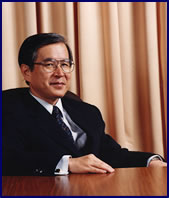 |
|
| LEADING
MARKET |
Sri
Lankan Telecom (SLT) ended the year on a high note with
an after tax profit of Rs. 2,685 million. This was up
by 28% from a year earlier. Revenue grew by 15% and net
assets at the end of year was Rs. 38,787 million.
SLT continues to lead the field in the telecommunications
industry. Approximately 87% of the fixed line subscribers
in this country were using SLT at the end of 2002. At
the end of the year SLT had 768,620 direct exchange lines
(DELs). The Company has doubled the number of DELs by
adding 486,997 DELs over a five year period.
With its acquisition of Mobitel in October 2002, third
largest mobile operator, SLT becomes the only integrated
operator in this country to offer fixed line, data and
mobile services.
The revenue generated from domestic telephony, as a proportion
of SLT’s overall revenue, continued to grow in 2002.
In 2002, as much as 55% of our revenue was generated from
domestic telephony operations. This is an inevitable consequence
of our tariff rebalancing policy and this trend is likely
to continue for a few years. Approximately 77% of domestic
telephony revenue comes from call charges. |
|
|
| |
| THE
MOBITEL ACQUISITION |
In October
2002 SLT acquired Mobitel, one of the four mobile operators in the
country. Previously, SLT had bought a 40 per cent stake in Mobitel,
when the mobile operator commenced operations in 1996. In October
2002 SLT invested Rs. 922 million to Telstrar of Australia to acquire
the balance 60 per cent. Mobitel currently has approximately 112,000
subscribers and a 18 per cent slice of the mobile market in the country.
Mobitel currently operates an AMPs network. Over the next few years
Mobile will commence a phased transfer of its subscribers from its
AMPs network to a state-of-the-art GSM network. The Telecommunications
Regulatory Commission of Sri Lanka (TRCSL) has given us an assurance
that Mobitel will be able to operate a GSM mobile service. The BOI
has approved the continuation of the tax exempt status of BOI after
SLT’s purchase of that company.
The future expansion and development of Mobitel will be an important
part of SLT strategy for the next phase. Over the next few years SLT
will focus on transforming Mobitel into a state-of-the-art mobile
operator and will actively seek to increase its customer base.
The Mobitel acquisition has placed SLT even further ahead of other
service providers. Currently SLT is the only operator in this country
to offer integrated voice, data and mobile solutions. Coupled with
our countrywide digital transport network, our computerized billing
system and our standards of customer care, SLT is well placed to create
new markets while offering new solutions. |
| |
| THE
SLT IPO |
Our
Initial Public Offering (IPO) in November 2002 raised Rs. 3,249 million.
This was one of the biggest public offering that the local market
has witnessed.
As a result of this IPO the ownership of SLT has undergone a radical
change: |
| |
| Government of
Sri Lanka |
49.5% |
| NTT Communications Corporation |
35.2% |
| Public |
15.3% |
|
| |
| SLT
became the largest listed company in the Colombo Stock Exchange with
this IPO. The IPO has broadbased our share structure. |
| |
 |
|
| ALLIANCE
WITH NTT |
NTT
Communications Corporation has been our strategic partner
as we have transformed from a lethargic state entity to
a dynamic state-of-the-art service provider. Our alliance
began when NTT bought a 35% slice of the Company in 1997.
This was accompanied by a management agreement through
which NTT agreed to provide strategic management advice
and training to SLT. The NTT stake was subsequently transferred
to NTT Communications Corporation.
The alliance blossomed during these five years and is
reflected in the transformation that has occurred in SLT’s
management culture and performance. From a top heavy and
loosely focused organization SLT has metamorphosed into
customer driven, technologically innovative and lean entity. |
|
|
| |
NTT
has provided strategic advice and support in a number of areas: network
design, service platforms and information technology. It has also
assisted in strengthening operating and financial reporting systems
and controls.
The NTT service agreement ended on 4th August 2002. However, further
to a shareholders’ agreement NTT Communications Corporation
has nominated four members to the SLT Board. The CEO and Chief Financial
Officer are also nominees of NTT Communications Corporation. |
| |
| GROWING
WITH OUR NETWORK |
SLT
will continue to modernize and strengthen its network as it gears
for an anticipated demand of its products. SLT’s fully digital
transport network covers most of the country, except some areas of
the North and the East. We hope to re-establish access in those areas
as normalcy returns. In the North and the East, providing a conducive
environment exists, SLT will focus on installing cost effective cable
and wireless local loop networks in a bid to meet the demand in those
areas.
At the end of 2002 SLT’s network consisted of over 500 digital
exchanges divided into 29 area codes each served by a secondary switching
centre. The secondary switching centres are in turn connected to four
tertiary switching located in Colombo, Kandy, Galle and Anuradhapura.
These four centres connect to the national centre in Colombo. Trunk
transmission between secondary and tertiary switching centres is mainly
through microwave link.
A number of network expansion projects are in the pipeline. These
include a project to increase the switching capacity in the Colombo
Metropolitan Area by 109,050 lines and an upgrade of the transmission
system. |
| |
| EXPANDING
OUR INTERNATIONAL OPERATIONS |
In these
five years SLT has considerably strengthened its international
network with a view to enhancing its global connectivity and
international traffic routes.
Its current network consists of three gateway exchanges, two
cable landing stations, three satellite earth stations and one
mobile earth station. This network is supplemented by the access
that SLT has to two submarine cables: SEA-ME-WE II and SEA-ME-WE
III.
In September 2002 SLT entered into an understanding with 12
other international operators to collaborate on the construction
of a new SEA-ME-WE IV submarine cable which is expected to go
into operation in 2004.
In October 2002 SLT signed an agreement with Bharti Telesonic
of India in a bid to strengthen traffic between the two countries.
Interconnection will be provided through SEA-ME-WE III and Network
i2i in Singapore.
The Company’s international operations will be strengthend
by the establishment of points of presence outside Sri Lanka
to offer termination, hubbing and transit services to overseas
telecommunications service providers. |
|
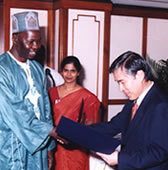 
SLT is a recognised
training resource provider to Commonwealth countries, on par
with the UK, Australia, Canada and Malaysia. |
|
| |
| Since
1997 SLT has pursued a policy of rebalancing tariffs between domestic
and international rates so as to reflect the actual costs of these
services. This policy will be continued and in early 2003 international
rates were drastically reduced. |
| |
| MAINTENANCE |
SLT
upgraded its maintenance capabilities in 2002 by installing four centralised
outside plant maintenance centres (OPMCs) in the Colombo Metropolitan
Area. Nine more will be established during 2003 and further strengthen
our maintenance capability. OPMCs enable an automation of systems
and a pooling of resources. This keeps human resource costs down and
provides for a more efficient and cost effective system all round.
The fault rates and fault clearance rates have continued to improve
over the past five years. SLT has put in place a comprehensive maintenance
management plan developed in connection with NTT Communications Corporation.
This has been boosted by an increased emphasis on maintenance training
of SLT’s technical staff.
In 1998 SLT set up a fault reporting call centre and has now put in
place centralized fault reporting management systems. Our maintenance
capabilities are further enhanced by our large maintenance fleet islandwide. |
| |
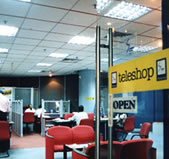 |
|
| TELESHOPS |
Our
teleshops have revolutionised telecommunications marketing.
Our first four teleshops were opened in 1997 and another
19 have been established since then.
These teleshops are one stop centres and perform a variety
of functions. Customers may pay their bills, lodge a complaint,
register for a new telephone or invest in a range of new
equipment, in a customer friendly environment. The goal
has been to create a customer friendly environment at
a single location and provide a wide range of services
at this single location. This has increased levels of
customer satisfaction and generated enormous goodwill. |
| |
|
|
| |
| INTERNET
CUSTOMER BASE GROWS |
Our
Internet customer base grew by 23% in 2002. SLT’s internet service
was launched in 1996 and by the end of that year we had 1,200 customers.
Our service was re-launched in 2000 as SLTNet and as part of this
re-launch SLT set up a help desk and lowered its rates.
Our customer base has now grown to 40,705 a growth of 93% in two years.
Our internet marketing strategy has been to offer competitive pricing,
a high quality of service and high speed access.
SLT has points of presence (POPs) across the country and this allows
our subscribers to access the net for the cost of a local call. SLT’s
international IP (Internet Protocol) backbone bandwidth is 90 Mbps.
SLT currently offers Internet leased lines at 64 kbps, 512 kbps, 2
Mbps, client mail service installation, web and DNS hosting as well
as POP internet service.
Internet customers are now provided with an E fax service enabling
them to direct their mails to fax. Internet Roaming was introduced
in 2000 and this created an interest particularly among those customers
who travel frequently. It enables them to use their Internet account
while travelling. The Roaming Service is now available in 150 countries
through 15,000 ISP POPs. Web Hosting, DNS Hosting and Top Level Domain
Name Registrations are some of the other services customers have access
to.
SLT Broadband took off the ground with successful telemarketing in Slave Island.
The SLT Broadband will consist of 512 kbps and 2 Mbps download services along
with 128 kbps and 512 kbps upload speeds respectively. |
| |
| MOVING
TOWARDS MORE VALUE ADDED SERVICES |
Over
the next few years SLT will develop its existing value added services
and introduce new services so as to increase our subscriber base and
generate more revenue.
We will focus on promoting our existing services such as IDD, voicemail,
call waiting, call forwarding and other packaged service offerings.
Itemised billing and on line billing services will be introduced in
due course.
We propose to increase our revenue from international operations though
the wider use of calling cards, pre-paid cards, post-paid cards and
budget IDD services to users in Sri Lanka and abroad. |
| |
| DATA
SERVICES |
SLT
provides data services under the brand name SLTData.
SLT’s data circuits have a capacity of 64 kbps and 8 Mbps. Our
services include national and internationals leased circuits, frame
relay solutions and internet leased circuits. Customers include mobile
operators, data service operators, internet providers, software developers,
banks and other large corporations. At the end of 2002 we had approximately
2,800 data customers.
SLT will leverage its fibre optic infrastructure to provide IP-based
services such as SLT Broadband, IPVPN and Internet data centres. These new
products will be aimed at the high usage corporate customers and will
increase our network utilization. In addition we hope to put in place
an IP backbone covering the Colombo Metropolitan Area by mid 2003
and in the other areas by the end of 2004. The IP backbone will be
connected to global networks through SLT’s international gateways. |
| |
| REGIONAL
PERFORMANCE |
For
operational reasons SLT is divided into four regions:
Metro which consists of Colombo and its suburbs,
Region 1 which consists of the Central, Western / North, North Western
and North Central provinces,
Region 2 which consists of the Uva, Southern, Sabaragamuwa and Western
/ South provinces and Region 3 which consists of the Northern and
Eastern provinces. |
| |
 |
 |
| METRO
REGION |
| 30,360 new
customer lines were provided in 2001 taking the overall
Metro customer base to 345,087. The metro region is one
of the most important regions for SLT. It accounts for
45% of SLT’s total customer base and 48% of SLT’s
revenue. |
|
|
| |
| ZERO
FAULTS IN THE METRO REGION |
Metro
Region achieved a major milestone in 2000 when all faults reported
within the day were completely cleared. The achievement of Zero Faults
Status (no unattended fault left overnight) was a significant achievement
for SLT and is a standard we intend taking to other regions over the
next few years.
This landmark was achieved through a number of preventive measures
which included keeping the number of faults down, and training our
staff to respond to faults promptly. In 2001 we increased our fibre
optic network to key customers and enhanced the number and quality
of our maintenance vehicles.
In 2002 we set up four centralised outside plant maintenance centres
(OPMCs) in the Region. Nine more will be established during 2003.
We propose to connect our maintenance vehicle through a radio network
during 2003. |
| |
| REGION
1 |
| Region
1 consists of nine RTOM areas: Kandy, Gampola, Matale, Kurunegala,
Chilaw, Anuradhapura, Polonnaruwa, Negombo. During 2002 the customer
base increased by 19,590 and brought the total number of customers
in the region to 211,986 by the end of the year. |
| |
| REGION
2 |
Region
2 consists of 11 RTOM areas: Kegalle, Avissawella, Ratnapura, Badulla,
Bandarawela, Hatton, Nuwara Eliya, Kalutara, Galle, Matara and Hambantota.
16,174 new connections were established in 2002 bringing the overall
customer base in the region to 173,186. |
| |
| REGION
3 |
One
of SLT's strategies over the past few years has been to develop the
switching and transmission capacities in difficult areas. With this
in view SLT has embarked on a major infrastructure development programme
in those areas.
In Jaffna, 967 new connections were provided during 2002.
A total of 3,850 new connections were provided in the region during
2002. |
| |
| INFORMATION
TECHNOLOGY |
SLT
is progressively improving its IT infrastructure through the enhanced
use of computerized information systems. Currently finance functions,
human resources administration, procurement and inventory management,
billing, fault reporting and new connection management operate on
separate systems. Our plan is to have an integrated system for these
functions which would ensure greater accuracy and more efficiency.
A new billing system and customer care system will be in operation
by the end of the year.
The headquarters and all regional offices are linked by Intranet.
Each department maintains a web page and dissemination of information
among the different offices and departments has increased significantly. |
| |
| HUMAN
RESOURCES |
We recognize
that our greatest resource continues to be our employees. We are committed
to provide a friendly working environment to encourage their personal
involvement and development.
SLT would like to create an environment for its staff that is productive,
satisfying and creative. A job in the Company should not be a mere
source employment, but a career and a part of a lifestyle. It is with
the intention of creating a ‘total environment’ that a
review of its human resource systems has been initiated.
During 2002 our human resource training policy focused on customer
orientation; team building; interpersonal cooperation; workplace cooperation;
IT skills; communication skills; productivity improvement and attitude
development. |
| |
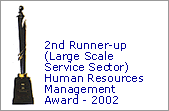 |
|
In a clear endorsement of the
Company’s HR practice, SLT was selected as the 2nd Runner
Up in Human Resource Management in a competition run by the
Post-Graduate Institute of Management of the University of Sri
Jayawardhenapura.
In the first phase after privatization senior management was
given priority. This has now changed and our training schemes
have been broadened to include middle and junior level management
and technical staff. Where our in-house training capacities
are insufficient we use external consultants. |
|
| |
Our
human resource strategy for the short term will focus on a better
utilisation of existing human resources. One of the tasks in the near
future will be to review job profiles and to look at ways of improving
employee relationships and communication skills.
The major focus of these initiatives exercise will be to trigger initiative
and to reward dynamism and creativity. To us as at SLT learning is
a continuous process and this is another value we are trying raise.
We will continue with our transformation into a customer oriented
enterprise that provides customers with consistent and high quality
service.
Another of the strategic concerns at SLT is our recruitment procedures
and its procedures. In the future the recruitment of personnel will
strictly be a needs based exercise. Because SLT offers a satisfying
and rewarding environment the productivity levels of our staff are
high as reflected in the staff productivity ratios.
Our new human resource policy includes increased outsourcing of non-core
functions and rationalization of our cadre through voluntary retirement
schemes.
A number of other measures have been implemented to ensure that SLT’s
work culture is more performance and profit driven. Apart from new
training programmes, annual performance appraisals and Japanese productivity
improvement measures such as ‘Kaizen’ and ‘5S’
have also been integrated. Promotions are now based on competitive
examinations which have created a learning culture in the organization.
SLT currently has 33 unions. Sixteen of these have formed an umbrella
organization, the Joint organization of Telecommunication Trade Unions.
Currently no formal collective bargaining agreement exists with the
unions. However, SLT has struck a number of informal agreements with
the unions on wages, bonuses and related matters. The current state
of industrial relations is harmonious and the management and employees
have been able to resolve disputes amicably.
Several employee involvement programmes have been initiated. This
included a collaborative management programme sponsored by the International
Labour Organization. As a result local and regional discussion groups
between management and the staff have been set up to encourage participatory
management and to resolve conflicts through dialogue and negotiation.
This has created an entirely new work ethic in the organization based
on mutual understanding and cooperation and has created win-win situations
for both management and employees.
Our new human resource policy will focus on developing a committed
and dynamic workforce which can adapt to the latest technologies.
It will facilitate the emergence of a company with the right size
and optimal number of employees. We will aim to foster an organizational
climate which supports higher productivity through improved workplace
cooperation. Key competencies of our employees will be enhanced to
keep pace with technological developments. Developing a learning and
knowledge based organization with state-of-the-art solutions, will
be one of the main drivers of this new policy. |
| |
| EVOLVING
A RESPONSIBLE CORPORATE CITIZENSHIP |
Good corporate
citizenship demands good values and at SLT we are committed
to creating a better society for us all. While wealth
creation is one of the primary motivating forces we are
also conscious of our role in enhancing the social wealth
of the entire society. We are conscious of the strategic
role we play as the major provider of voice and data communications
in this country.
This is why while seeking to infuse quality into every
aspect of our production process we have tried to ensure
that this quality percolates to society in general. Good
corporate citizenship demands social responsibility. The
creation of a content and satisfied consumer base is of
vital importance to our longer term strategic goals and
we are dedicated to spreading the value of this responsibility. |
|
|
 
Web Spinners Unite |
|
| |
Giving
tangible form to this aspect of our business, SLT launched “Web
Spinners Unite” – a programme for students, conducted
in collaboration with The Chartered Institute of Management Accountants
(CIMA) introducing them to the wonders of new age communication and
information technology. Subjects such as the Internet, e-Commerce,
e-Learning, Career Guidance on the Internet, the New Economy, Payment
and Security, Web Design for e-Commerce and Internet Marketing Basics,
were explained and students were afforded hands-on experience in these
areas. “Web Spinners Unite” ran in Kandy, Galle, Colombo,
Nikeweratiya, Jaffna, Vavuniya and Ratnapura.
SLT’s commitment to social responsibility also encompasses care
for the environment. It is a sad fact that today, all manner of flora
and fauna are threatened with extinction through man’s irresponsible
and thoughtless actions. The Company seeks to raise awareness of the
plight of species of endemic birds of Sri Lanka, whose numbers are
dwindling by the year. As our mite towards their cause, we featured
12 out of 23 endemic birds in our wall calendar for 2003. We’ve
also featured them on the screen saver and as wall paper on our website
– www.slt.lk.
Our role as a responsible corporate citizen of Sri Lanka takes many
forms. From donating school books to disaster relief, career development
programmes such as the one we ran in collaboration with The Chartered
Institute of Management Accountants, Chartered Institute of Marketing,
Institute of Personnel Management Sri Lanka (Inc.) and The Institute
of Chartered Secretaries and Administrators in Sri Lanka in four districts
and blood donation campaigns, SLT is committed to the welfare of Sri
Lanka and its people. |
| |
| CORPORATE
GOVERNANCE |
Accompanying
corporate responsibility is an effective system of corporate governance.
To guarantee shareholder rights we have put in place an effective
system of checks and balances through our new corporate governance
structure. This has included the appointment of 4 eminent personalities
as non executive directors, the establishment of an Audit Committee
and a Remuneration Committee and the adoption of a transparent process
of management.
We have been guided by the Code of Best Practice issued by the Institute
of Chartered Accountants and have through our systems of corporate
governance sought to balance at all times our corporate objectives
with shareholder accountability. |
| |
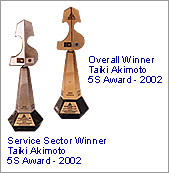 |
|
| PRODUCTIVITY
AND QUALITY |
| One of the
key distinguishing characteristics of a successful company
is a high level of productivity. SLT launched a concerted
drive to achieve greater productivity, across the organization.
We are happy to report that SLT won the 2nd Runner Up
Prize at “National Human Resources Management 2002”,
a competition held by the Post Graduate Institute of Management
(PIM) of the University of Sri Jayawardenapura and the
Institute of Personnel Management (IPM). SLT won for its
function as a major partner contributing significantly
to Sri Lanka’s economic infrastructure. It was also
rewarded for making a successful transition from a Government
institution into a more private sector oriented company. |
|
|
| |
One
of the key drivers that helped SLT win this award was the “5S”
and “Kaizen” programs put in place to achieve efficiency
and quality. The successful implementation of these programs achieved
great recognition as SLT swept the board at Taiki Akimoto 5S Awards
Ceremony held recently. SLT won 13 awards and 2 Certificates of Excellence,
competing against many prominent government and private sector institutions.
We were thus adjudged Overall Winners.
The aims of the competition are to reward outstanding and innovative
achievements in pursuing quality awareness and productivity. |
| |
| CREATING
A SLT BRAND |
SLT
has emerged as a truly Sri Lankan brand and a brand that Sri Lankans
will view with pride. We are in the process of seeking legal protection
for this brand.
Our brand identity is a fluctuating one, as new products and services
emerge, flourish and get disseminated. We will continue to build value
for our brand and maintain it as a brand that symbolizes quality and
appeals to those in both rural and sophisticated markets. |
| |
| THE
WAY FORWARD |
As we
commence 2003 we are confident that the processes of change unleashed
in 1997 will continue. There are strong signs that the economy is
beginning to recover. Economic growth coupled with increasing investor
and consumer confidence will be the external catalysts. Internally
we will continue to refine our systems, enhance customer support and
access the very best in technology.
The telecommunications regulatory environment in Sri Lanka is undergoing
big changes. A new draft policy on telecommunications has been released
by government and SLT is in the process of studying this. It is likely
that the industry will be further liberalized and more operators are
likely to enter the market. SLT is gearing to meet these challenges.
My thanks to our employees for another productive year. Their contribution
has yet again been a strong one. My thanks also to the Board for their
support and to the TRC for the cooperation they have extended. We
look forward to another rich year. |
| |
Shuhei
Anan
Chief Executive Officer |
 |
| |
| |